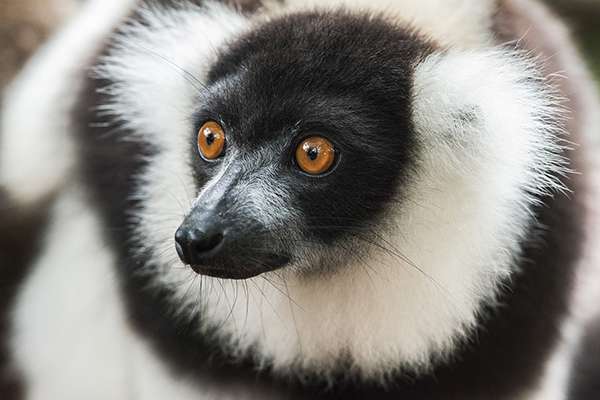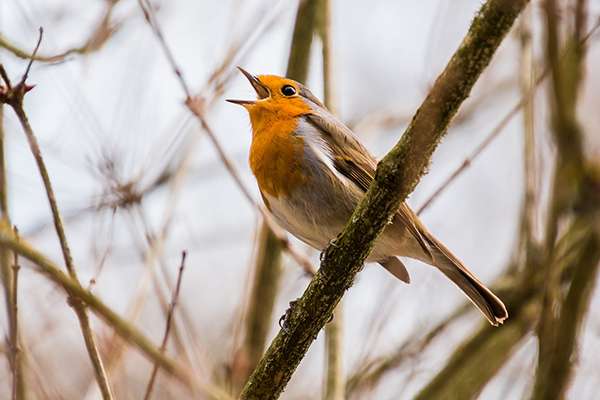What Animals Have A Sense Of Rhythm

Researchers recently set out to look for musical abilities in lemurs, which volition permit them to build an "evolutionary tree" of musical traits and sympathize how rhythm originated and evolved in humans.
Y'all probably practise it in the car. Some of us practise it in the shower. And when no one else is home, a good number of united states of america might even do information technology in front end of the mirror with an imaginary microphone.
And then, there are those who do it in the rain (I'm looking at you, Gene Kelly.)
We sing. The ability to carry a melody isn't fifty-fifty all that important considering the very act of singing—even off-key—makes us feel skillful. Singing has the power to change our moods and conjure upwards memories. It provides an emotional release; a style to express our thoughts and feelings.
But is our human bent for music and rhythms unique in nature? Do other animals take senses of rhythm like ours? Of course, ane of the most striking similarities between humans and birds is the ability to make vocal. And nosotros know that dolphins and whales can create complex musical phrases; only other than those exceptions, the chapters appears to be rare in the natural globe.

For us, singing provides an emotional release; we sing to express our thoughts and feelings. Like the adage says, "Where words fail, music speaks."
Now, nonetheless, researchers report that they may take found a sense of rhythm in another primate—and that our notions of what a "vocal" is may not be applicable when we look at other fauna cultures.
Indri intervals
Unlike a painting or a piece of sculpture, which are compositions in space, a musical work is dependent upon time. In other words, rhythm is music's blueprint in time. Whatsoever other elements a given piece of music may accept (such as pitch or timbre), rhythm is the one indispensable component in all music. Rhythm can exist without tune—every bit in the drumbeats of some indigenous music—but melody cannot exist without rhythm.
Evolutionary theory maintains that physical characteristics develop considering they're needed; because they bring their owner an advantage. But what need was there for the homo throat to have evolved a larynx that can produce such musically accurate sounds, over such an astonishing range? Any that need, it must have existed a very long time ago to permit such a complex anatomical device to develop. It may fifty-fifty accept existed among our far distant, humanoid ancestors before our species,Homo sapiens, appeared on Earth.

Birds and humans share the ability to make songs. But that skill seems to exist rare in the natural world.
So, practise other, nowadays-day primates showroom senses of rhythm? An international team of researchers endeavored to notice out.
For their written report, the scientists chose i of the few "singing" primates, the critically endangered lemurIndri indri. Visiting the rain forests of Madagascar to collaborate with a local primate study grouping, the researchers investigated whether indri songs have categorial rhythm, a "rhythmic universal" found across homo musical cultures. Rhythm is categorical when intervals between sounds have the same duration (1:1 rhythm) or doubled elapsing (ane:two rhythm). This type of rhythm makes a song easily recognizable, even if it is sung at unlike speeds.
Rain forest ritardando
Over a menses of 12 years, the investigators recorded songs from twenty indri groups (39 animals), living in their natural habitats. Indri family group members tend to sing together, in harmonized choruses and duets. The enquiry team constitute that indri songs had the archetype rhythmic categories (both i:one and 1:2), as well as the typical ritardando (a gradual slackening in tempo) found in several human musical traditions. Male and female lemur songs had a different tempo only showed the same rhythm.

Well over one-half of Republic of madagascar's species are found in the rain forests, which lie on the isle's due east coast.
Co-ordinate to the report'due south authors, this is the offset evidence of a rhythmic universal in a nonhuman mammal. But why should another primate produce categorical, music-similar rhythms? The ability probably evolved independently among singing species, as the last common ancestor betwixt humans and indris lived 77.5 million years agone. Ane theory is that rhythm may brand information technology easier to produce and procedure songs, or even to learn them.
Cetacean changes
While whales take been identified equally one of those other, rare mammals that sing, it could be that their songs defy the human definition of a vocal.
Many scientists frame whale songs as similar to bird vocalizations, designed for attracting potential mates or warnings to competitors. But for the past several years, researcher Eduardo Mercado III, at the University at Buffalo in New York, has been proposing a radically different story almost whale songs. In his latest study, published in the journal Animal Cognition in August 2021, he argues for a divergence from treating whale songs as the underwater analog to birdsong.

Scientists deploy a hydrophone in the Due north Atlantic that will tape sounds emitted by endangered whales and other species. ©Dave Mellinger, Oregon Country University, flickr
His findings reveal the changing nature of the units within whale songs and the way they farther morph through the years. These changes stand for a vocal flexibility that demonstrates the inadequacy of using human labels—such as cries, chirps and moans—for a species with the capacity for much more sophisticated audio production. What the whale singers are doing seems to be much more dynamic, both within songs and across years, making it a matter of switching from thinking nigh whale songs as musical notes to something more free-form, such every bit dancing.
Electric current hypotheses assume whales combine sounds (units) into patterns (phrases) to construct the songs that reveal their fitness to possible mates. From this perspective, single units are like individual quills in a peacock'south tail, each functionally equal and useful only as a collective. Only the units are not functionally equal, co-ordinate to Dr. Mercado's paper. The unit morphing produces some units that are much less detectable than others, a finding that challenges previous conclusions regarding fitness in favor of the songs instead signifying locations and movements, with each change making relevant units easier to hear beyond long distances.
There are clear differences in the units when listening to whale songs from different years, says Mercado. They're so different that it'due south similar switching from one musical genre to another. In any given year, the whales utilize an altogether different gear up of sounds.

Previously, it was assumed that whales combine sounds into patterns to create songs that advertise their breeding fitness. From this perspective, unmarried units are like individual quills in a peacock's tail, each functionally equal and useful only as a commonage.
Could these changes be random? It's not likely. Dr. Mercado relied on a method that collected detailed measures of variations in units produced by whale singers, and so he compared those measures to characteristics produced in dissimilar years. This arroyo emphasized variability in vocal behavior rather than summaries of unit types.
Dr. Mercado likened the changes to people with no preparation shifting languages several times over a 10-year bridge, and everyone continuing to understand everyone else despite it. So, if the whales are changing sounds, how are other whales making sense of them?
It seems that the modifications adhere to a articulate set of rules, such every bit maintaining pitch ranges fifty-fifty when the sounds announced subjectively to be varying quite a flake. The morphing of these units might contribute to the overall function of the songs, peradventure by increasing the number of positions from which listening whales can reliably detect, localize and runway the tunes.

At least one researcher wants us to recall of whale songs non every bit musical notes merely like something more than complimentary-form, such equally dancing. ©Navin75, flickr
That flexibility demonstrates the shortcomings inherent in computational or subjective methods for sorting units into discrete categories that don't capture nuances of vocalizations. Shifts in pitch, for example, might force an incorrect recategorization of units. Nosotros might call back nosotros're hearing something different, only the whale might be saying nix has changed.
Humans, Mercado concludes, are not the gold standard for distinguishing sounds, and we must admit and respect that when conducting enquiry.
Songs for sensibilities
We have a lot to learn about the "songs" of other animals. In recognition of that fact, the authors of the lemur rhythm study encourage other researchers to gather data on indris and other endangered species "before information technology is also late to witness their breathtaking singing displays."

The lemur-report scientists encourage other researchers to get together data on indris and other endangered species with rhythm to acquire more than about the musical propensities we share before it'south also late.
Primarily, humans sing because something within us needs to express something beyond words.
I think that may exist the major reason the "others" among us exercise, too.
Here's to finding your truthful places and natural habitats,
Candy
Source: https://www.nathab.com/blog/a-sense-of-rhythm-birds-lemus-whales-and-us/
Posted by: bonnerwerve1939.blogspot.com

0 Response to "What Animals Have A Sense Of Rhythm"
Post a Comment